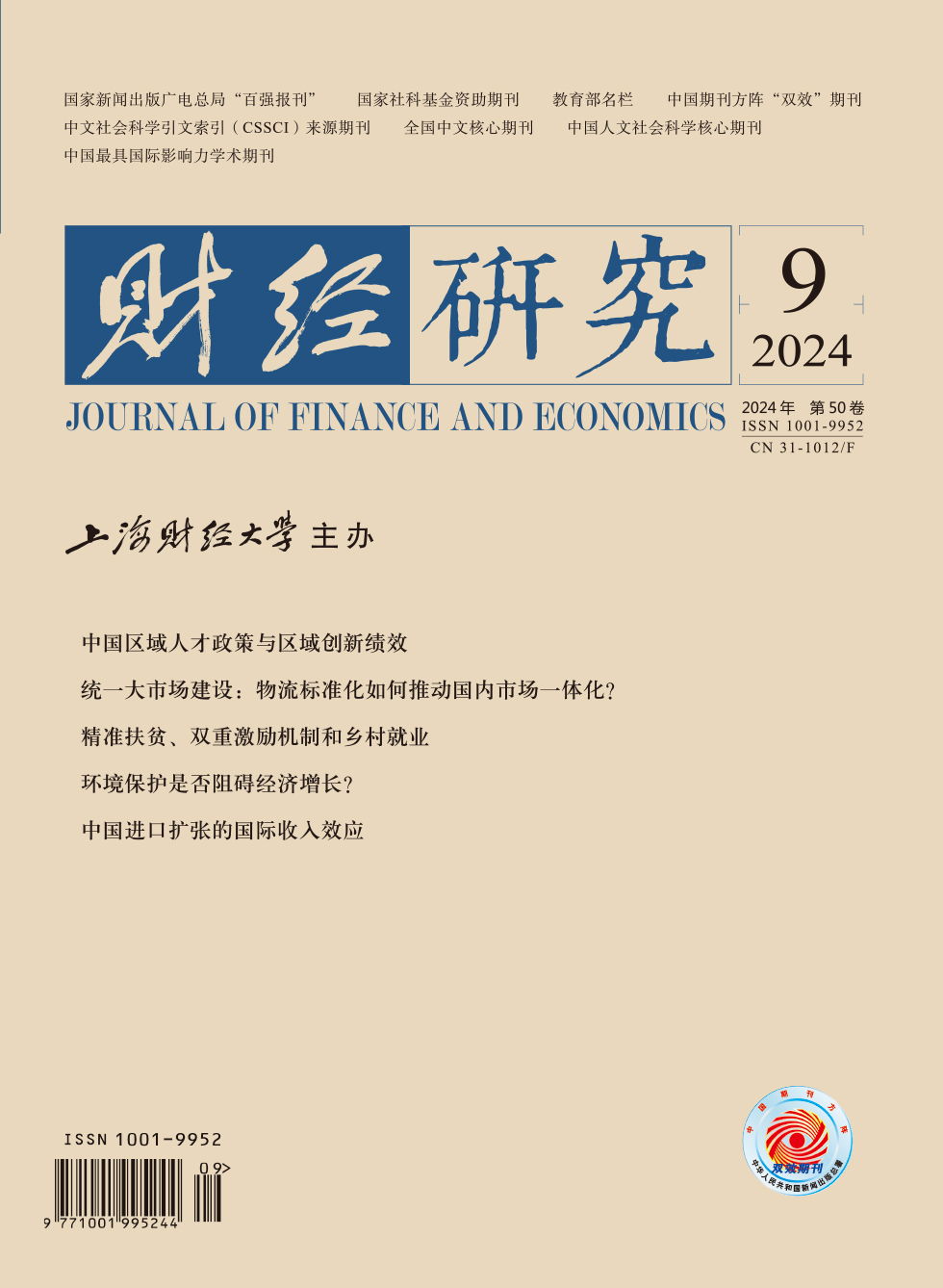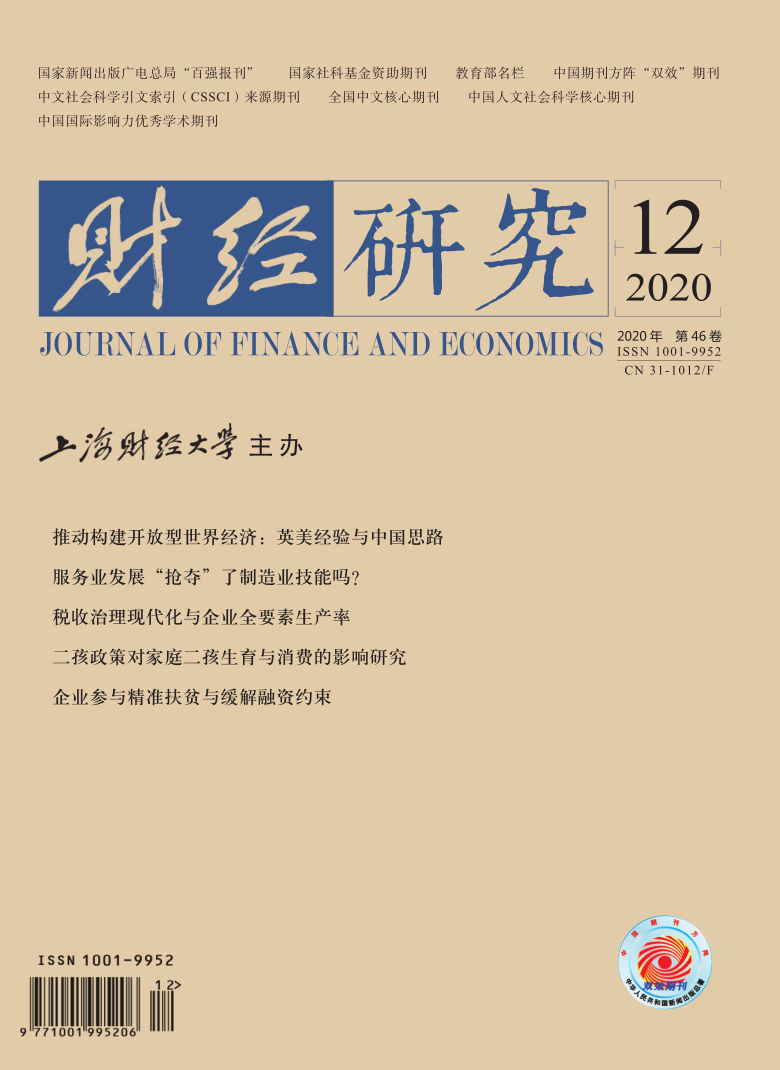[1]Cai F. How Can Chinese economy achieve the transition toward total factor productivity growth?[J]. Social Sciences in China, 2013, (1): 56-71. (In Chinese)
[2]Cai F. The key to future growth will be to increase total factor productivity[N]. Economic Information Daily, 2017-11-11. (In Chinese)
[3]Gong G, Hu G L. Efficiency of resource allocation and manufacturing total factor productivity in China[J]. Economic Research Journal, 2013, 48(4): 4-15. (In Chinese)
[4]He G H, Yang X Y. The effect of financial constraints on productivity in China: The difference test between state-owned enterprises and private enterprises based on systematic GMM method[J]. The Journal of Quantitative & Technical Economics, 2012, 29(5): 19-35. (In Chinese)
[5]Hou Q S, Yuan J G, Zhang P. Does corporate tax avoidance behavior affect bank debt contract? An empirical research using China’s listed company data[J]. Nankai Business Review, 2016, (4): 122-134. (In Chinese)
[6]Jiang X Y. Tax enforcement, tax aggressiveness and stock price crash risk[J]. Nankai Business Review, 2013, (5): 152-160. (In Chinese)
[7]Ju X X, Ru D, Yu Y H. Financing constraints, working capital management and the persistence of firm innovation[J]. Economic Research Journal, 2013, (1): 4-16. (In Chinese)
[8]Li S F, Jin L Q. Financing constraints, financing channels and business TFP: A test of China’s industrial enterprises based on GPSM method[J]. Journal of Jiangxi University of Finance and Economics, 2015, (2): 20-31. (In Chinese)
[9]Li W A, Xu Y K. The effect of political identity on tax avoidance[J]. Journal of Financial Research, 2013, (3): 114-129. (In Chinese)
[10]Lin Y F, Li Z Y. Policy burden, moral hazard and soft budget constraint[J]. Economic Research Journal, 2004, (2): 17-27. (In Chinese)
[11]Liu C, Sun L. Can tax enforcement decrease stock price crash risk?[J]. Journal of Financial Research, 2015, (8): 159-174. (In Chinese)
[12]Liu X, Ye K T. Does corporate tax avoidance affect investment efficiency?[J]. Accounting Research, 2013, (6): 47-53. (In Chinese)
[13]Liu J W, Chen L C. Toward the modernization of the governance of tax collection: A commentary on the revised draft of the law on the administration of tax collection[J]. Journal of The Party School of The Central Committee , 2015, (2): 42-50. (In Chinese)
[14]Liu S X. Tax collection and management concerns national governance[N]. China Financial and Economic News, 2016-2-23(006). (In Chinese)
[15]Liu X X, Wu Y B. Enterprises productivity and its sources: Innovation or demand push?[J]. Economic Research Journal, 2009, (7): 45-54. (In Chinese)
[16]Liu Y M. Tax administration: Rule of law, Co-governance and good governance[N]. China Taxation News, 2015-4-22(B03). (In Chinese)
[17]Liu Y S, Li J J. A study on the tax functions for promotion of the modernization of state governance[J]. Taxation Research, 2019, (4): 14-18. (In Chinese)
[18]Liu Z, Wu J G. “Multicenter” governance: Another perspective of tax management mode transformation[J]. Taxation Research, 2012, (10): 73-76. (In Chinese)
[19]Li Z, Li Y. Tax enforcement, tax avoidance, and enterprise total factor productivity: Evidence from the corporate income tax reform[J]. Finance & Trade Economics, 2019, (7): 5-19. (In Chinese)
[20]Mao C L, Ji L. Research on the influence of tax rate on tax evasion behavior of foreign-funded enterprises[J]. The Journal of World Economy, 2014, (6): 73-89. (In Chinese)
[21]Ren S M, Lv Z. The financial constraints, the government subsidies and the factor productivity: A case study on the equipment-manufacturing enterprises in China[J]. Management World, 2014, (11): 10-23. (In Chinese)
[22]Shi X J, Zhang S M. Trade credit, credit constraints and impacts on efficiency: Empirical evidences from China[J]. Economic Research Journal, 2010, (1): 102-114. (In Chinese)
[23]Sun P Y, Li F Y, Gu L J. Whether trade credit can be an efficient finance channel for firms: Based on the perspective of investment[J]. China Economic Quarterly, 2014, (4): 1637-1652. (In Chinese)
[24]Sun X J, Zai S P, Yu S. Can flexible tax enforcement ease corporate financing constraints: Evidence from a natural experiment on tax-paying credit rating disclosure[J]. China Industrial Economics, 2019, (3): 81-99. (In Chinese)
[25]Tang W B, Fu Y H, Wang Z X. Technology innovation, technology introduction and transformation of economic growth pattern[J]. Economic Research Journal, 2014, (7): 31-43. (In Chinese)
[26]Tong J Z, Huang K L, Lin D S. Tax collection and management, tax compliance and business operation efficiency: Empirical evidences from China’s listed companies[J]. Contemporary Finance & Economics, 2016, (3): 24-32. (In Chinese)
[27]Wang W, Guo X Q, Ai C R. Financing constraints, the decline of labor’s share and China’s low consumption[J]. Economic Research Journal, 2013, (11): 100-113. (In Chinese)
[28]Wang Y T, Wang Guo Jun, Peng Y. Does ownership nature affect tax sensitiveness? Evidence based on firm’s labor demand[J]. Economic Research Journal, 2012, 47(4): 52-63. (In Chinese)
[29]Wu X F, Liang A Q, Li F. System credit environment, financial constraints and firm innovation[J]. Inquiry into Economic Issues, 2018, (12): 70-80. (In Chinese)
[30]Xiang S L, Wei H. The effect of liquidity constraints on firm productivity[J]. Statistical Research, 2014, (3): 27-36. (In Chinese)
[31]Ye K T, Li X. The levy and supervision of taxes, the cost of income tax, and the management of earnings[J]. Management World, 2011, (5): 140-148. (In Chinese)
[32]Yu K P. Governance and good governance[M]. Beijing: Social Sciences Academic Press (CHINA), 2000. (In Chinese)
[33]Zeng A M, Wei Z H. Financial constraints, financial flexibility and investment-cash flow sensitivity: Theoretical analysis and empirical evidence from listed companies in China[J]. The Study of Finance and Economics, 2013, (11): 48-58. (In Chinese)
[34]Zeng Y M, Zhang J S. Can tax collection and administration play the role of corporate governance?[J]. Management World, 2009, (3): 143-151. (In Chinese)
[35]Zhang B. Thinking on the promotion of the tax governance modernization[J]. Fiscal Science, 2018, (8): 23-27. (In Chinese)
[36]Zhang L B. Modernization of tax administration: from reality to realization[J]. Taxation Research, 2015, (10): 70-74. (In Chinese)
[37]Zhang Y Y, Zhang D Y. Can trade credit Increase the firms’ TFP? A perspective from financial constraints of Chinese firms[J]. Public Finance Research, 2019, (2): 116-128. (In Chinese)
[38]Zhu K, Chen X Y. Financial development, audit opinion and financing[J]. Journal of Financial Research, 2009, (7): 66-80. (In Chinese)
[39]Biddle G C, Hilary G. Accounting quality and firm-level capital investment[J]. The Accounting Review, 2006, 81(5): 963-982.
[40]Brown J R, Fazzari S M, Petersen B C. Financing innovation and growth: Cash flow, external equity, and the 1990s R&D boom[J]. Journal of Finance, 2009, 64(1): 151-185.
[41]Caggese A, Cuñat V. Financing constraints, firm dynamics, export decisions, and aggregate productivity[J]. Review of Economic Dynamics, 2013, 16(1): 177-193.
[42]Färe R, Grosskopf S, Norris M, et al. Productivity growth, technical progress, and efficiency change in industrialized countries[J]. The American Economic Review, 1994, 84(1): 66-83.
[43]Gatti R, Love I. Does access to credit improve productivity? Evidence from Bulgaria[J]. Economics of Transition, 2008, 16(3): 445-465.
[44]Hsieh C T, Klenow P J. Misallocation and manufacturing TFP in China and India[J]. Quarterly Journal of Economics, 2009, 124(4): 1403-1448.
[45]Li W, Pittman J A, Wang Z T. The determinants and consequences of tax audits: Some evidence from China[J]. Journal of the American Taxation Association, 2019, 41(1): 91-122.
[46]Levinsohn J, Petrin A. Estimating production functions using inputs to control for unobservables[J]. The Review of Economic Studies, 2003, 70(2): 317-341.
[47]Olley G S, Pakes A. The dynamics of productivity in the telecommunications equipment industry[J]. Econometrica, 1996, 64(6): 1263-1297.
[48]Richardson S. Over-investment of free cash flow[J]. Review of Accounting Studies, 2006, 11(2-3): 159-189.






 4569
4569  4505
4505

